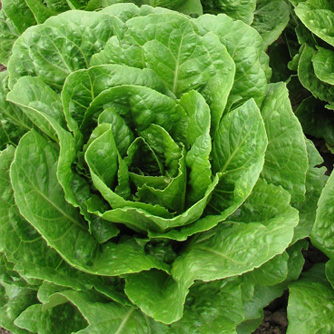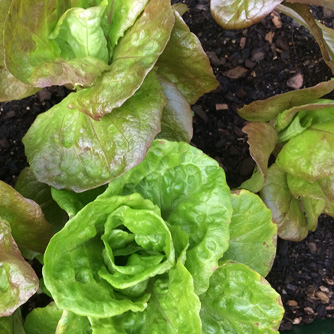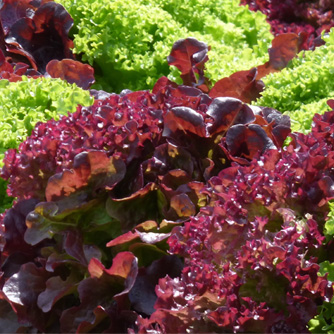Lettuce
BackLettuce (Lactuca sativa) has been recorded as being grown since as early as 500 BC making it the number one all time salad ingredient ever! Not surprisingly with all that time under cultivation there are now many different types of lettuces you can grow eg compact head varieties (like Iceberg), open head types (Cos) and loose leaf forms (Oakleaf).
Loose leaf lettuces are increasingly popular as you can pick individual leaves as you need them without having to pick the whole plant. Plus they’re easier to grow than compact head varieties and will perform well in pots and containers. So if you’ve never grown lettuce before start off with a loose leaf type.
How To Grow Lettuce
Although lettuce is officially a cool weather annual it can be grown all year round by seed or seedlings. Just take care in summer months to ensure the plants receive shade from the hot afternoon sun and plenty of water. If the plants suffer from stress they can become bitter and will bolt to seed prematurely. Some varieties will perform better at different times of the year (especially the compact head types) so pay attention to the instructions on the seed packet. If in doubt just stick to growing the loose leaf types which are less fussy.

Cos lettuce
Start with a sunny position and enrich the soil with compost, manure and organic pelleted fertiliser. A dose of dolomite is also recommended to get the pH right (6.5-7.5). Lettuce require a lot of moisture and because of this are susceptible to rotting so good drainage is also a requirement. If planting into clay soil, apply gypsum to improve the structure of the soil.
Seed can be sown into punnets or scattered directly over the soil and covered lightly. Lettuce seed is very fine so take care to evenly space the seeds. Keep moist until seeds germinate (usually a week or so) and then as the plants grow you may need to thin them out. Sow more seeds every 3-4 weeks for a continuous supply of tasty lettuce.
Whether you start from seed or seedlings water in with OCP eco-seaweed to get them going and once established mulch with sugarcane to help retain moisture and keep weeds at bay.
Sowing Guide for Lettuce
| Growing Zone | Sowing Time |
| Cool Zones | Spring, Summer, Autumn, Winter |
| Mediterranean Zones | Spring, Summer, Autumn, Winter |
| Warm & Temperate Frost Free Zones | Spring, Summer, Autumn, Winter |
| Tropical & Subtropical Zones | Spring, Summer, Autumn, Winter |

Young green and bronze mignonette lettuces
Fertilising Lettuce
Lettuce needs to be grown quickly with plenty of moisture and regular feeding. Apply a mixture of OCP eco-seaweed and OCP eco-aminogro every 2 weeks to quickly produce strong healthy plants. Regularly applying this solution will ensure your harvest stays nice and sweet.
During hot weather apply OCP eco-hydrate to the soil to attract and store moisture as well as help reduce plant stress.
Harvesting Lettuce
Lettuce is best harvested in the morning when leaves are freshest. Pick loose leaf varieties one leaf at a time starting from the outer leaves. If you need a lot of leaves you can cleanly cut all the leaves at the base at one time with these varieties. Keep feeding and watering the trimmed lettuce base and it will continue growing new leaves from the centre.
With heart or head forming varieties the whole plant is harvested at once. This can be done at anytime once the heart has formed. If you leave it too long though the heart will start opening up as the plant moves into flowering and seed production. The leaves will lose their sweetness and start to taste bitter.

Very distinctive "Lollo Rossa" lettuce with red frilled leaves
Pests and Disease Problems for Lettuce
Common problems of lettuce are:
- Snails and slugs are big fans of lettuce so check for their slimy trails and apply OCP eco-shield as required.
- Whitefly will commonly attack plants and can be controlled with OCP eco-oil.
- Aphids are another sap sucker that can attack and may also spread viruses. Spray with an organic insecticide to get rid of them.
- Caterpillars can also cause a lot of damage so keep a sharp eye out and pick them off when you see them. Read our caterpillar guide for additional tips.
- Bolting is another common problem as lettuce are shallow rooted and will go to seed early when heat stressed. Keep plants well watered and mulched through the warmer months or grow loose leaf varieties.
- Rots, spots and mildews are caused by numerous bacteria or fungi that can attack lettuces. Symptoms range from leaf spots, rotting tissue, wilting and stunted roots. Control is difficult once present so focus on preventative measures: ensure plants are well watered but with good drainage and airflow between them, apply regular doses of OCP eco-seaweed and OCP eco-aminogro for strong healthy growth and practice crop rotation.
- Viruses can also infect plants and cause stunted blotchy growth. Remove diseased plants immediately and be vigilant about controlling sap suckers on new plants.

Green and bronze oakleaf lettuces are a loose leaf type


